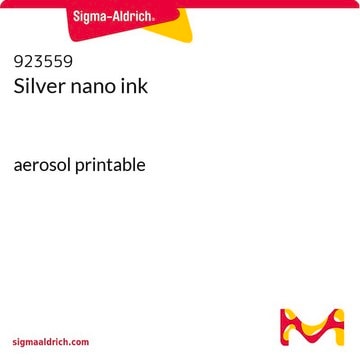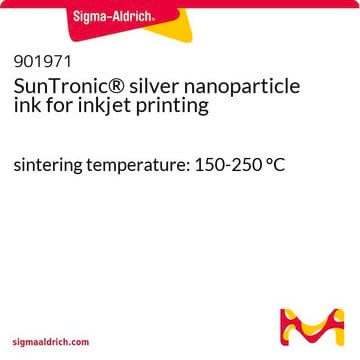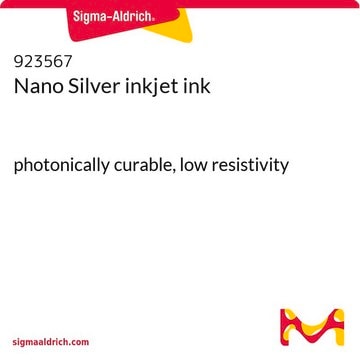The detailed preparation method for the silver nanoparticles in this product is considered proprietary and cannot be disclosed. Generally, commercial methods for creating a stable dispersion include using surfactants, stabilizers, or dispersing agents. Additionally, techniques such as sonication and high-shear mixing can be effective for achieving stable dispersions. These methods can also be applied when preparing a paste of copper nanoparticles in a similar solution.
おすすめの製品
詳細
Silver content : 75 wt%
Solvent : Diethylene Glycol Mono Butyl Ether (DGBE)
Surface Tension : 28 dyn/cm (Pendant Drop)
フォーム
paste
粒径
50-70 nm (by Lumisizer™)
90-120 nm (by Lumisizer™)
粘度
50,000-100,000 cP (Shear Rate: 1 s-1
250cP - 450 cP (Shear Rate: 1000 s-1))
密度
2.85-3.3
保管温度
15-25°C
関連するカテゴリー
アプリケーション
The ink offers:
- Uniform and reproducible donor layer with low drying speed
- Stable accurate jetting in different types of laser systems, wide working window of jetting parameters
- High speed printing (20-50kHz), allowing high throughput
- Narrow patterning on plastic and glass substrates (line width ∼50 μm, height ∼0.5 μm, spacing ∼50 μm)
- Laser sintering of LIFT printed pattern, providing good electrical properties
Fit for:
LIFT digital printing
Additive electronic manufacturing
Printed electronics: RFID, FPD, Sensors
Laser induced forward transfer printing (LIFT) is a non-contact, nozzle-free, one step, direct laser writing process.[1][2]
LIFT can operate under atmospheric conditions, is compatible with low laser fluences, allows the printing of organic and inorganic materials as well as biological elements. The printing process can take place from both liquid and solid phases. It further has a high lateral resolution only defined by the laser spot size. It is a method compatible with inorganic semiconductor sensor fabrication, OLED fabrication and bio printing[3].
その他情報
*Parameters should be optimized depending on line geometry and substrate
保管および安定性
法的情報
シグナルワード
Warning
危険有害性情報
危険有害性の分類
Aquatic Acute 1 - Aquatic Chronic 1 - Eye Irrit. 2
保管分類コード
10 - Combustible liquids
WGK
WGK 3
引火点(°F)
Not applicable
引火点(℃)
Not applicable
適用法令
試験研究用途を考慮した関連法令を主に挙げております。化学物質以外については、一部の情報のみ提供しています。 製品を安全かつ合法的に使用することは、使用者の義務です。最新情報により修正される場合があります。WEBの反映には時間を要することがあるため、適宜SDSをご参照ください。
PRTR
第一種指定化学物質
労働安全衛生法名称等を表示すべき危険物及び有害物
名称等を表示すべき危険物及び有害物
労働安全衛生法名称等を通知すべき危険物及び有害物
名称等を通知すべき危険物及び有害物
Jan Code
907669-VAR:
907669-5G:
907669-BULK:
最新バージョンのいずれかを選択してください:
この製品を見ている人はこちらもチェック
資料
Small molecular weight organic semiconductors are promising for flexible transistor applications in next-gen soft electronics.
Professors Tokito and Takeda share design principles and optimization protocols for organic electronic devices, focusing on flexibility and low cost.
時任教授と竹田教授が、フレキシビリティと低コストに重点を置いて、有機エレクトロニクスデバイスのための設計原則と最適化のプロトコルを紹介します。
アクティブなフィルタ
ライフサイエンス、有機合成、材料科学、クロマトグラフィー、分析など、あらゆる分野の研究に経験のあるメンバーがおります。.
製品に関するお問い合わせはこちら(テクニカルサービス)










